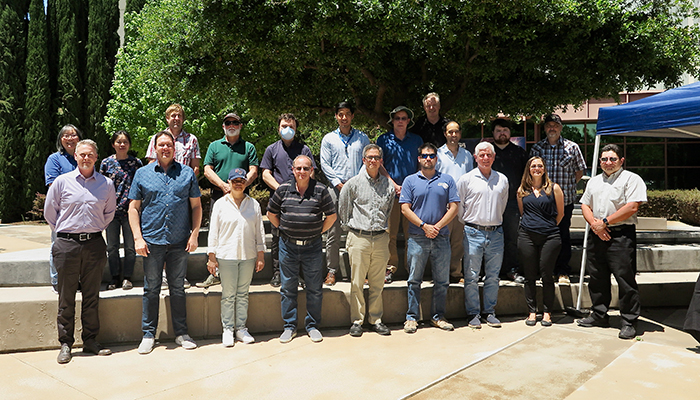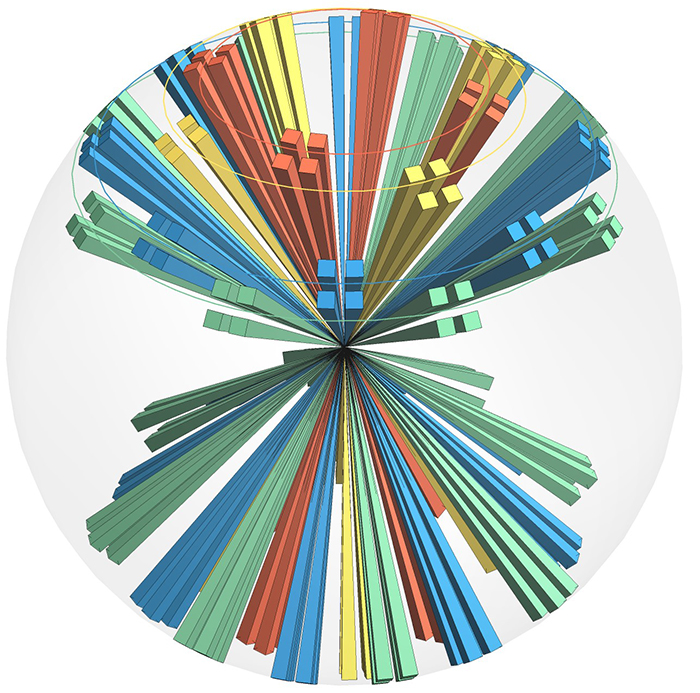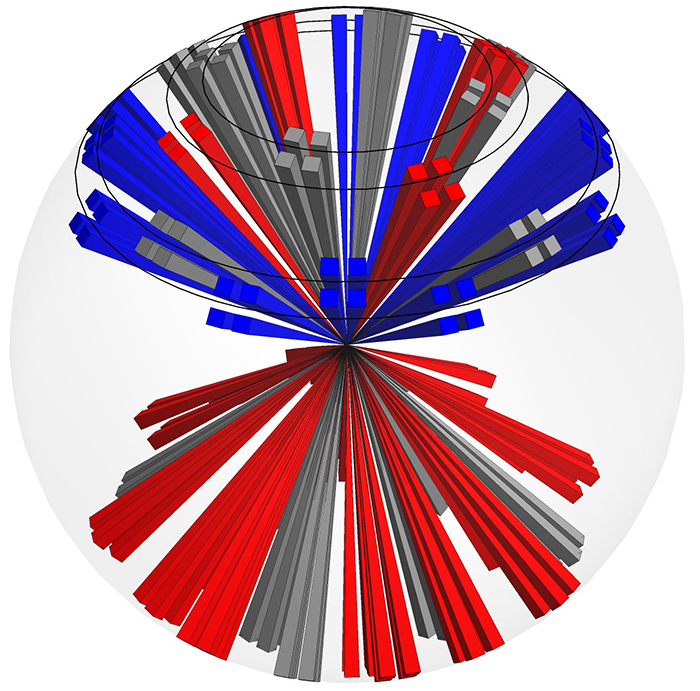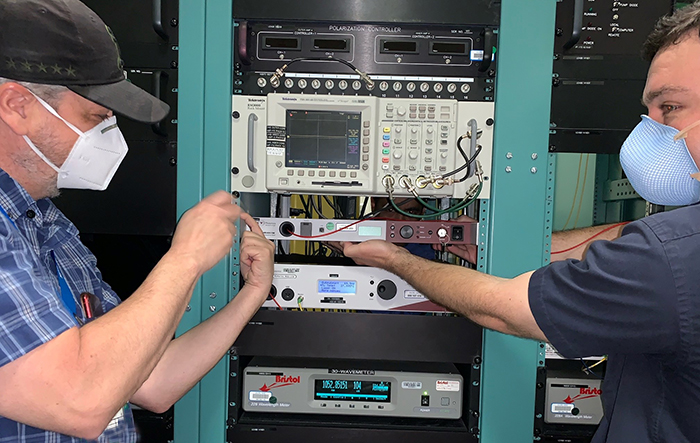NIF’s Master Oscillator Room Upgrade Completes Key Milestone
August 24, 2022
 A May 25 celebration was held for the NIF Master Oscillator Room (MOR) team that revitalized the MOR, including the Flexible Color Mapping (FlexCM) project. Front row, from left: Gordon Brunton, Troy Morris, Bela Patel, Misha Shor, Robert Fallejo, Steve Sauter, Doug Larson, Shannon Ayers, and Jean-Michel Di Nicola. Back row, from left: Cathy Chang, Joyce Li, Rich Beeler, Doug Speck, Matt Prantil, Leyen Chang, Larry Pelz, Alan Casey, Vincent Hernandez, Tyler Dumbacher, and Chris Kinsella. Not shown: Anumeha Bhasker, Chantal Burgoyne, and Brett Raymond. Credit: Sylwia Hamilton
A May 25 celebration was held for the NIF Master Oscillator Room (MOR) team that revitalized the MOR, including the Flexible Color Mapping (FlexCM) project. Front row, from left: Gordon Brunton, Troy Morris, Bela Patel, Misha Shor, Robert Fallejo, Steve Sauter, Doug Larson, Shannon Ayers, and Jean-Michel Di Nicola. Back row, from left: Cathy Chang, Joyce Li, Rich Beeler, Doug Speck, Matt Prantil, Leyen Chang, Larry Pelz, Alan Casey, Vincent Hernandez, Tyler Dumbacher, and Chris Kinsella. Not shown: Anumeha Bhasker, Chantal Burgoyne, and Brett Raymond. Credit: Sylwia Hamilton The National Ignition Facility’s Master Oscillator Room (MOR)—the so-called “heart of the laser”—recently completed a three-year modernization project with a prominent, state-of-the-art feature being its support of direct-drive, Flexible Color Mapping (FlexCM) experiments.
“I feel great. It is so exciting to get it done,” said NIF Laser Systems Engineering Leader Jean-Michel Di Nicola. “The MOR was 20 years old, and we have been talking about modernizing it for the last five-plus years, if not more.”
New MOR architecture from the oscillator to the pulse shaping system input was designed, tested, and deployed over the past two years. Older optical fiber amplifiers were replaced with newly designed, robust units and the fail-safe systems were updated with modernized designs that improve performance as well as the overall operation. More than 30 chassis of old equipment were replaced.
The MOR is a compact laser oscillator that generates low-energy laser pulses that are shaped in time and frequency-broadened to help smooth the intensity of the laser beam when it is ultimately focused on the target.
For each of NIF’s 192 beams, the pulse shape, as a function of time, must be generated with a high degree of precision, and the energy delivered to the target must be precise.
The MOR began being used about 20 years ago, and in over the course of time, the technological obsolescence of the same equipment and architecture became an issue of concern.
Discussions for a major MOR upgrade began at Lawrence Livermore National Laboratory (LLNL) around 2019. The MOR upgrade is part of an overall NIF refurbishment plan.
A special NIF MOR team was assembled, and in early 2019, began to implement a multi-year plan to improve the NIF system-level performance in a phased approach stemming from 3w frequency conversion issues and pulse shape droop and more stringent ignition requirements.

Di Nicola and MOR Project Engineer Larry Pelz had high praise for the MOR teams involved with the three-year upgrade.
“They were extremely dedicated, and they delivered under short timelines and maintenance periods were kept to a minimum,” Di Nicola said. “It was a high-stress environment to deliver things.”
Pelz added: “It was well-orchestrated by consistently applying systems engineering practices, a lot of upfront scheduling and planning, and the execution. And it’s because of that—the months and months of planning and scheduling—that we can do all the work we can do in a two- or three-week period.”
Di Nicola likened the work of the team to the efforts of a Formula 1 racing pit crew that stabilizes the car, changes tires, adjusts aerodynamics, and safely releases the vehicle—all in a matter of a few seconds.
The shot set-up tool, laser performance operations model, and integrated computer control system software had to be modified to check whether the new configuration was correctly applied without adversely affecting the existing baseline configuration.
He also praised management for fully backing the project, ranging from supporting a MOR team that examined the myriad issues and providing funding for quality work to allowing time for the team to come up with a schedule.
FlexCM
A prominent feature of the upgrade is its support of direct-drive, Flexible Color Mapping (FlexCM) experiments for the Laboratory for Laser Energetics (LLE) of the University of Rochester. LLE conducted experiments using the new system about a week after it became available.
NIF beams start as invisible infrared light, which special optics convert into visible green light and then to invisible, high-energy ultraviolet light directed in four groups of laser beams, called quads, toward and eventually into the Target Chamber. The beams are arranged into two separate cones to allow time-dependent control of drive symmetry. An inner cone is directed toward the waist of the target hohlraum, and an outer cone pointed near the ends of the hohlraum.
New optical amplifiers for the inner cones and a new patch panel allows for three new NIF color mappings, distributing the set of four laser wavelengths to specific quads.
The FlexCM capability allows for colors to be reshuffled in three additional ways to mitigate cross-beam energy transfer and increase the laser energy absorbed by a directly driven capsule. Previously, the color mapping configuration was imposed on the cone to which it belonged.


The baseline color mapping image (left) shows how, before the MOR upgrade, the beams within the same cone (same polar angle on the chamber) had to use the same wavelength. The tri-color mapping image (right) shows how the upgrade added more degrees of freedom by allowing three new configurations where beams within the same cone can use different colors.
LLE worked with NIF’s MOR team to create FlexCM because they determined, from a target physics point of view, that the coupling efficiency would be increased compared to the previously available configuration, according to Di Nicola, group leader for laser modeling and analysis under Laser Science and System Engineering, and NIF laser systems chief engineer.
“From a hardware perspective, FlexCM was really quite simple,” said Pelz, who was also in charge of the FlexCM. “We basically designed a system in the Master Oscillator Room that would allow us to remap colors.”
The team had to ensure the system adhered to the strict safety protocols while making sure “we were tuning the crystals correctly for the right wavelength,” Peltz said.
 MOR staff members Chris Kinsella (left) and Matt Prantil (right) install hardware in the Master Oscillator Room as part of an upgrade. Credit: Tyler Dumbacher
MOR staff members Chris Kinsella (left) and Matt Prantil (right) install hardware in the Master Oscillator Room as part of an upgrade. Credit: Tyler Dumbacher A luncheon was held May 25 to congratulate the NIF MOR 2.0 development team for its work in completing the modernization project. The impact of the MOR upgrade is that the NIF laser is currently operating at its highest sustained levels of energy and power, and Di Nicola credited continued investments by NNSA in optics and laser technology. The fidelity of the laser models, accuracy of the laser diagnostic, beam quality, front-end performance and low-mode symmetry have all been improved.
NIF MOR team members were:
MOR2.0 Leadership Team: Di Nicola, Pelz, and John Heebner.
MOR Operations Team: Vincent Hernandez, Matt Prantil, Chris Kinsella, and Tyler Dumbacher.
MOR Pre-shaped Pulse Generation & Flexible Color Mapping Design & Engineering Team: Adrian Barnes, Rob Barnes, Jason Beagle, Rich Beeler, Anumeha Bhasker, Donald Browning, Chantal Burgoyne, Pete Cardinale, Richard Carr, Cathy Chang, Leyen Chang, Raelyn Clark, Alex DeLand, Peter DeVore, Gaylen Erbert, Robert Fallejo, Ron House, Victor Khitrov, Willie Lew, Chris Marshall, Troy Morris, Valier Pacheu, Ernesto Padilla, Yan Pan, Bela Patel, Luka Papike, Mitanu Paul, Brett Raymond, Steve Sauter, Mike Shaw, Misha Shor, Sukhraj Singh, Tom Spinka, Victor Tejeda, Suzy Townsend, Roger Tran, Lei Wang, Susan West, Steven Yang, Charles Yu, and Haiyan Zhang.
—Jon Kawamoto
Follow us on Twitter: @lasers_llnl



